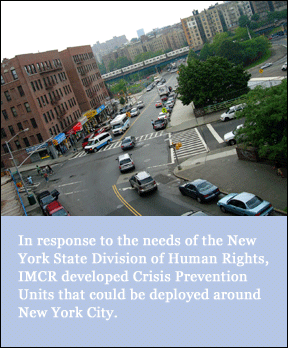 The late 60's and 70's was a period of unprecedented social upheaval in this country particularly in urban areas. Conflicts that arose in communities were often laced with undertones of racial and cultural bias. Groups stood in opposition to one another. The need for communication was particularly pressing because many groups felt that established institutions discriminated according to race or cultural heritage. From 1972 to 1975 IMCR worked to ease inter-group tensions by facilitating dialog between communities in conflict. In the aftermath of racial incidents between White, Black and Hispanic students at Lehman High School in Throgs Neck, IMCR pulled together parents and civic leaders under the auspices of the Bronx Borough President to work through how to head off future incidents. Similarly when disputes broke out between Puerto Ricans and Hasidic Jews in the Williamsburg section of Brooklyn, IMCR played a guiding role in opening communications between the different groups. Each case demonstrated the extraordinary benefits of community dialog. More information on IMCR's involvement in resolving these disputes can be found in 'Conflict', IMCR's quarterly, Vol. 1, No. 1 in September of 1973.
The late 60's and 70's was a period of unprecedented social upheaval in this country particularly in urban areas. Conflicts that arose in communities were often laced with undertones of racial and cultural bias. Groups stood in opposition to one another. The need for communication was particularly pressing because many groups felt that established institutions discriminated according to race or cultural heritage. From 1972 to 1975 IMCR worked to ease inter-group tensions by facilitating dialog between communities in conflict. In the aftermath of racial incidents between White, Black and Hispanic students at Lehman High School in Throgs Neck, IMCR pulled together parents and civic leaders under the auspices of the Bronx Borough President to work through how to head off future incidents. Similarly when disputes broke out between Puerto Ricans and Hasidic Jews in the Williamsburg section of Brooklyn, IMCR played a guiding role in opening communications between the different groups. Each case demonstrated the extraordinary benefits of community dialog. More information on IMCR's involvement in resolving these disputes can be found in 'Conflict', IMCR's quarterly, Vol. 1, No. 1 in September of 1973.
In recognition of IMCR's leadership and expertise, in the field of community conflict mediation, the organization was invited to provide technical assistance to lawmakers crafting what later became the New York State Community Dispute Resolution Bill which formally established the network of community dispute resolution centers that exist in every county of New York (now referred to as the Neighborhood Mediation Programs).
While situations involving racial or cultural differences may have been higher profile for IMCR, throughout its history the agency worked to  address an extremely wide range of issues that can effect a community whether that included housing issues, the location of service facilities or environmental concerns. IMCR provided mediation services in disputes pertaining to labor, college and police relations. By encouraging and empowering dialog, IMCR helped communities craft their own resolutions to their problems, solutions that reflected the needs of the community as opposed to decisions that impact the community, but are made by others. The early seventies was a period of dynamic growth for IMCR and it's success with encouraging community dialog derived from its insistence that decisions that are self determined are far more likely to be accepted and therefore to endure.
address an extremely wide range of issues that can effect a community whether that included housing issues, the location of service facilities or environmental concerns. IMCR provided mediation services in disputes pertaining to labor, college and police relations. By encouraging and empowering dialog, IMCR helped communities craft their own resolutions to their problems, solutions that reflected the needs of the community as opposed to decisions that impact the community, but are made by others. The early seventies was a period of dynamic growth for IMCR and it's success with encouraging community dialog derived from its insistence that decisions that are self determined are far more likely to be accepted and therefore to endure.
In the New York City area IMCR was instrumental in resolving conflicts at Community School Board District 3, at Direction Services Project (Los Padres Unidos/Sinergia, Inc. and between the New York City Housing Authority and its Resident Advisory Council. IMCR helped Staten Island develop its own Staten Island Mediation Council. And once again, after racial violence in Howard Beach, IMCR was called in to facilitate over 50 dialog groups around the city to help people address and understand racial and inter-group tensions.
In response to the needs of the New York State Division of Human Rights, IMCR developed Crisis Prevention Units that could be deployed around New York City, in areas like Yonkers and Wappinger Falls. At the same time IMCR designed and implemented conflict management training for all New York state conciliation specialists.
Over its four decades of existence IMCR has distinguished itself as one of preeminent sources for developing dispute resolution methodologies for communities and leaders. For instance, because of its long experience in mediating community conflicts and disputes IMCR was asked to train over 400 government officials and civic leaders from the New York City Personnel and City Planning Departments to prepare them for service as Community Board Liaisons.
IMCR has repeatedly demonstrated the proven community benefits when groups in conflict are brought together in a non-adversarial atmosphere by neutral third party mediators.